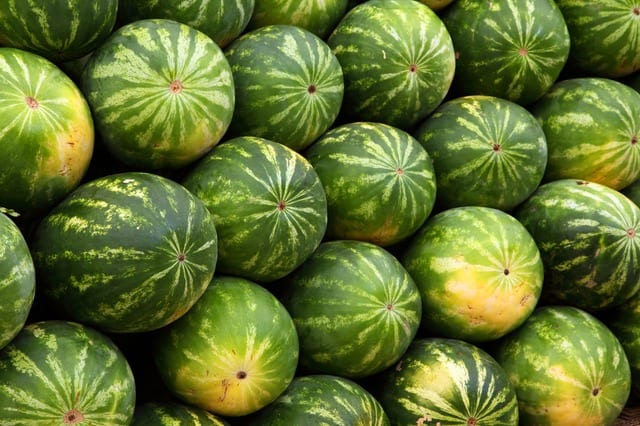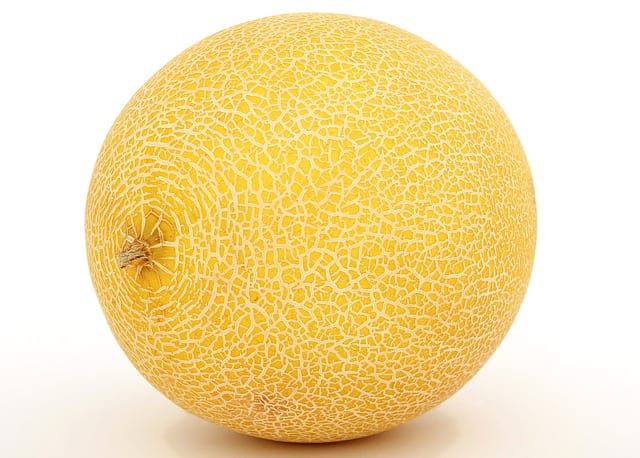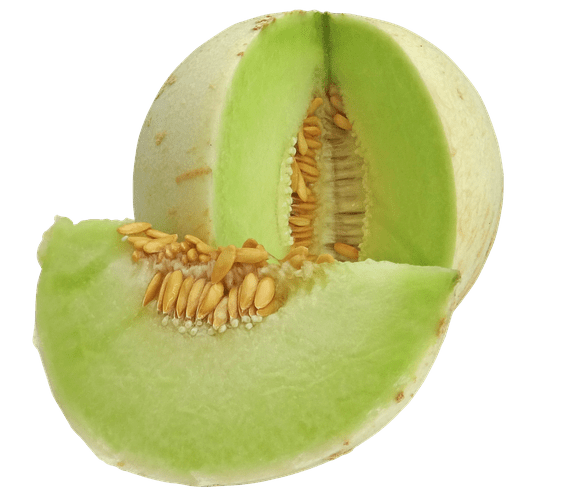Melons are a sweet summer treat in San Antonio. End of the school year pool parties wouldn’t seem complete without sticky melon juice running down children’s faces. Melons can offer immediate, cool, refreshing reprieve on a hot summer day. But have you also experienced that deflating feeling you get when you slice through the rind, crack your melons open, only to realize your melons weren’t ripe enough and your anticipated summer treat won’t be tasty at all? Today’s blog will help you figure out the best time to harvest your melons by revealing the signs melons give when they are ready to be cut from the vine.

(See those creamy-yellow spots on some of these watermelon? That’s the “ground spot” color you want for a ripe watermelon.)

(This ripe muskmelon has a gorgeous golden-orange hue under it’s webbing.)

(Creamy white is dyn-o-mite on this ripe honeydew.)

(Look for a dull, matte finish on watermelon rinds rather than shiny.)
1. Check the coloring of melons as they get close to harvest dates.
Watermelons: Look for a creamy-yellow color on the “ground spot”, the area of the watermelon that has rested on the ground as it ripens. It changes color from light green to creamy-yellow when ripe.
- If you’ve trellised your watermelons, they won’t have the ground spot, but you can look for a matte sheen as opposed to a shiny, glossy appearance.
- There should be little contrast of color between the stripes on the melons.
Muskmelons: Observe the color behind the netting of these melons. When ripe, the color changes from green to a creamy tan/golden-orange hue.
Honeydew melons: These melons should have a creamy, yellowish white color over the entire surface when ripe. Like watermelon, honeydew melons should have a more dull, matted appearance rather than shiny.
2. Observe the point where melons attach to the vine for changes.
Attention to changes in the attachment points of melons to their vines is probably the most dependable way to judge when your melons are ready to harvest.
Watermelons: Wait until the tendril (a curly, short stem-like, part of the vine) closest to where the melons are attached to the vine, has dried up. Use a sharp knife to cut melons from the vine leaving about half an inch of the vine attached.
Muskmelons: Wait until the area where these melons attach to the vine is cracked about ¾ of the way around. A ripe muskmelon will detach easily with slight pressure to the vine as these melons naturally separate from the vine when ripe. Best to harvest at this point rather than waiting for it to slip from the vine naturally (unless you are prepared to then eat it right away, as it will over-ripen in a matter of 36-48 hours).
Honeydew melons: Check for a slight softening at the attachment point when given slight pressure with your thumb, then use a sharp knife to cut melons from vine leaving about an inch of the vine attached.
3. Use a good, old-fashioned thumping technique.
Watermelons: This technique works, but it’s a learned skill. Take a finger or two and knock the melons sharply and quickly while listening for a hollow sound, which indicates ripe melons.
4. Employ your nose.
Muskmelons: While giving the end of the melons a little pressure and feeling for a slight softening, smell for a fresh, slightly sweet fragrance that is emitted when these particular types of melons are ripe.
A few other tips to keep in mind about melons
- Remember your planting dates to better judge when harvest time is close. Most melons require about 80-100 days from planting to harvest. If you are within that range, begin checking for the above signs that your melons are ripe.
- Find your sweet spot. Once melons are cut from the vine, they don’t continue to ripen or increase their sugar content. But left on the vine too long, melons can get mealy and their appeal goes downhill. Diligent observation in the garden close to your harvest dates will have you slicing into sweet, juicy melons in the perfect timeframe.
~The Happy Gardener


It is ok to plant melons seeds at the end of June?
Thenks❣
Yes you can. We wouldn’t suggest planting melon seeds later than beginning of July. As long as we don’t have an early frost, you should be fine for a fall harvest. Do some research for melons that have an earlier harvest time and you could be even more successful.
Sprite Melons are absolutely delicious and are what many consider to be a single serve melon for one or at most two people. When fully matured they are about the size of a softball and have a hard leathery firmness when GENTLY squeezed, and the skin color should be a light beige with only a hint of yellow and should be VERY smooth with a fine brown circular webbing pattern most noticeable near the blossom end. The blossom end should also emit a SPICY-SWEET fragrance. If the spicy-sweet fragrance is lacking; do not harvest it yet or you will be sorely disappointed. I say “skin” color because it really doesn’t have a rind. The “skin” is only about 1/8 to 1/4 inch thick so don’t squeeze test too hard or you will damage the fruit.
MMMMM! Sounds wonderful. Thanks for the tips!
I have honeydew melons growing in my garden, when checking to see it they re ready for harvesting, I press with my finger and my nail easily goes in. Does that mean it’s ready for harvesting.
Hi Karen,
That may be a sign, but check more with your fingerprint, rather than nail. The melon should have just a slight give to it. Also, use your sniffer. Ripe melons have a fresh, honey-sugar scent, and the melon should turn from green-white to a a creamy yellow tint.
What is the earliest time to plant
melons. Thank you!
Hi Lydia,
You will need to keep in mind how our weather patterns are looking, but generally, you do not want to plant melons until all danger of frost has passed. These are warm weather fruits that can be easily damaged by frost.
Early April is a good general time.
I read that you can start indoors and move outdoors later. Is this true and will this work.
Yes, you can start melons inside during late winter and early spring.
Hi!,
I have 3 varieties of watremelon growing, Sugarbaby (red flesh), Sweet Siberian (orange flesh) and Mountain Sweet Yellow (yellow flesh).
The first Sugarbaby with a dried tendril was sweet, but the seeds don’t look mature, and the flesh is very pale, almost yellow, almost orange in patches.
Can this be because of the different varieties growing together, or did I pick it not quite ripe? They have been growing for about 14 weeks (98 days) the vines are healthy etc.
Thanks in advance.
Hi Sean,
My first thought is that it wasn’t the Sugar Baby watermelon that you harvested and that it was the Sweet Siberian or the Mountain Sweet. Sugar Babies are purported to be ready at around 80 days, so it seems as though they would be ripe. Could you have mislabeled where you planted them? Where do you live, and what kind of weather have you been having? That’s what I can think of as far as being any setback to the harvest date. The dried tendril is a pretty good sign that it would be ready. (Also a yellow bottom and that “frosty” look should be going away).
Hi Sean I am growing a Ananas D Amerique melon . I have never grown melons before how will I know when it is ready to pick it. Thank you for any help you can give me. Bee
Hi Bee,
Look for increased netting pattern on the melon, and from what research I’ve gathered, this melon’s stem tends to “slip”, or drop when it is ripe. However, not all of them drop the stem, so when the stem starts to dry up, the base color gets more golden, and you begin to smell them, it’s most likely ripe. July – October is the general harvest time.